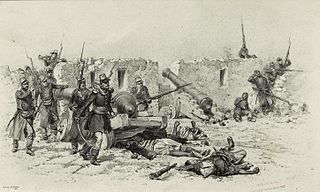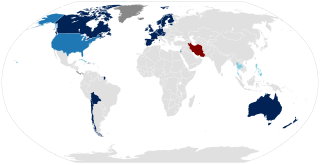
Military ranks are a system of hierarchical relationships, within armed forces, police, intelligence agencies or other institutions organized along military lines. The military rank system defines dominance, authority, and responsibility in a military hierarchy. It incorporates the principles of exercising power and authority into the military chain of command—the succession of commanders superior to subordinates through which command is exercised. The military chain of command constructs an important component for organized collective action.

Military recruit training, commonly known as basic training or boot camp, refers to the initial instruction of new military personnel. It is a physically and psychologically intensive process, which resocializes its subjects for the unique demands of military employment.
Morale is the capacity of a group's members to maintain belief in an institution or goal, particularly in the face of opposition or hardship. Morale is often referenced by authority figures as a generic value judgment of the willpower, obedience, and self-discipline of a group tasked with performing duties assigned by a superior. According to Alexander H. Leighton, "morale is the capacity of a group of people to pull together persistently and consistently in pursuit of a common purpose".. With good morale, a force will be less likely to give up or surrender. Morale is usually assessed at a collective, rather than an individual level. In wartime, civilian morale is also important.

Desertion is the abandonment of a military duty or post without permission and is done with the intention of not returning. This contrasts with unauthorized absence (UA) or absence without leave, which are temporary forms of absence.

The Individual Ready Reserve (IRR) is a category of the Ready Reserve of the Reserve Component of the Armed Forces of the United States composed of former active duty or reserve military personnel. Its governing statute is codified at 10 U.S.C. § 10144. For soldiers in the National Guard of the United States, its counterpart is the Inactive National Guard (ING). As of 22 June 2004, the IRR had approximately 112,000 members composed of enlisted personnel and officers, with more than 200 Military Occupational Specialties are represented, including combat arms, combat support, and combat service support.
Lesbian, gay, bisexual, transgender, and queer (LGBTQ) personnel are able to serve in the armed forces of some countries around the world: the vast majority of industrialized, Western countries including some South American countries such as Argentina and Chile in addition to South Africa, and Israel. The rights concerning intersex people are more vague.

A reservist is a person who is a member of a military reserve force. They are otherwise civilians, and in peacetime have careers outside the military. Reservists usually go for training on an annual basis to refresh their skills. This person is usually a former active-duty member of the armed forces, and they remain a reservist either voluntarily, or by obligation. In some countries such as Israel, Norway, Finland, Singapore, and Switzerland, reservists are conscripted soldiers who are called up for training and service when necessary.

Military recruitment refers to the activity of attracting people to, and selecting them for, military training and employment.

A military reserve force is a military organization whose members (reservists) have military and civilian occupations. They are not normally kept under arms, and their main role is to be available when their military requires additional manpower. Reserve forces are generally considered part of a permanent standing body of armed forces, and allow a nation to reduce its peacetime military expenditures and maintain a force prepared for war. During peacetime, reservists typically serve part-time alongside a civilian job, although most reserve forces have a significant permanent full-time component as well. Reservists may be deployed for weeks or months-long missions during peacetime to support specific operations. During wartime, reservists may be kept in service for months or years at a time, although typically not for as long as active duty soldiers.

Military personnel or military service members are members of the state's armed forces. Their roles, pay, and obligations differ according to their military branch, rank, and their military task when deployed on operations and on exercise.
Operation Gyroscope was a United States Army program implemented between 1955 and 1959 during the Cold War that modified the replacement system so that entire divisions were rotated out of overseas service together rather than as individuals. The program also applied to smaller nondivisional units, and was primarily used to exchange units between the United States and forces stationed in Germany under United States Army Europe. The system aimed to increase retention rates by boosting morale and unit cohesion with the added incentive of improving military family stability through keeping soldiers together for most of their careers. The program initially increased morale, but the Army was unable to keep its promises to soldiers and thus expected benefits failed to materialize, resulting in the early termination of the program after just one of the planned-three year rotation cycles had been completed.

Military sociology is a subfield within sociology. It corresponds closely to C. Wright Mills's summons to connect the individual world to broader social structures. Military sociology aims toward the systematic study of the military as a social group rather than as a military organization. This highly specialized sub-discipline examines issues related to service personnel as a distinct group with coerced collective action based on shared interests linked to survival in vocation and combat, with purposes and values that are more defined and narrow than within civil society. Military sociology also concerns civil-military relations and interactions between other groups or governmental agencies.

Combat is a purposeful violent conflict between multiple combatants with the intent to harm the opposition. Combat may be armed or unarmed. Combat is resorted to either as a method of self-defense or to impose one's will upon others. An instance of combat can be a standalone confrontation or part of a wider conflict, and its scale can range from a fight between individuals to a war between organized groups. Combat may also be benign and recreational, as in the cases of combat sports and mock combat.
The reserve components of the United States Armed Forces are military organizations whose members generally perform a minimum of 39 days of military duty per year and who augment the active duty military when necessary. The reserve components are also referred to collectively as the National Guard and Reserve.

A penal military unit, also known as a penal formation, disciplinary unit, or just penal unit, is a military formation consisting of convicts mobilized for military service. Such formations may consist of military prisoners convicted under military law, civilian prisoners convicted in civilian courts, prisoners of war who have chosen to side with their captors, or a combination of these groups.
Unit cohesion is a military concept, defined by one former United States Chief of staff in the early 1980s as "the bonding together of soldiers in such a way as to sustain their will and commitment to each other, the unit, and mission accomplishment, despite combat or mission stress". This concept lacks a consensus definition among military analysts, sociologists and psychologists, however.

An officer is a person who holds a position of authority as a member of an armed force or uniformed service.

The Junior Reserve Officer Training Corps is a federal program sponsored by the United States Armed Forces in high schools and also in some middle schools across the United States and at US military bases across the world. The program was originally created as part of the National Defense Act of 1916 and later expanded under the 1964 ROTC Vitalization Act.

Not all armed forces have policies explicitly permitting LGBT personnel. Generally speaking, Western European militaries show a greater tendency toward inclusion of LGBT individuals. As of January 2021, 22 countries allow transgender military personnel to serve openly: Australia, Austria, Belgium, Bolivia, Brazil, Canada, Chile, Czechia, Denmark, Estonia, Finland, France, Germany, Ireland, Israel, the Netherlands, New Zealand, Norway, Spain, South Africa, Sweden, and the United Kingdom. Cuba and Thailand reportedly allowed transgender service in a limited capacity.
The Israeli military consists of the Israel Defense Forces and the Israel Border Police, both of which engage in combat to further the nation's goals. Israel's military is one of the most accommodating in the world for LGBT individuals. The country allows homosexual, bisexual, and any other non-heterosexual men and women to participate openly, without policy-based discrimination. Transgender men and women can serve under their identified gender and receive gender affirming surgery. No official military policy prevents intersex individuals from serving, though they may be rejected based on medical concerns.



















